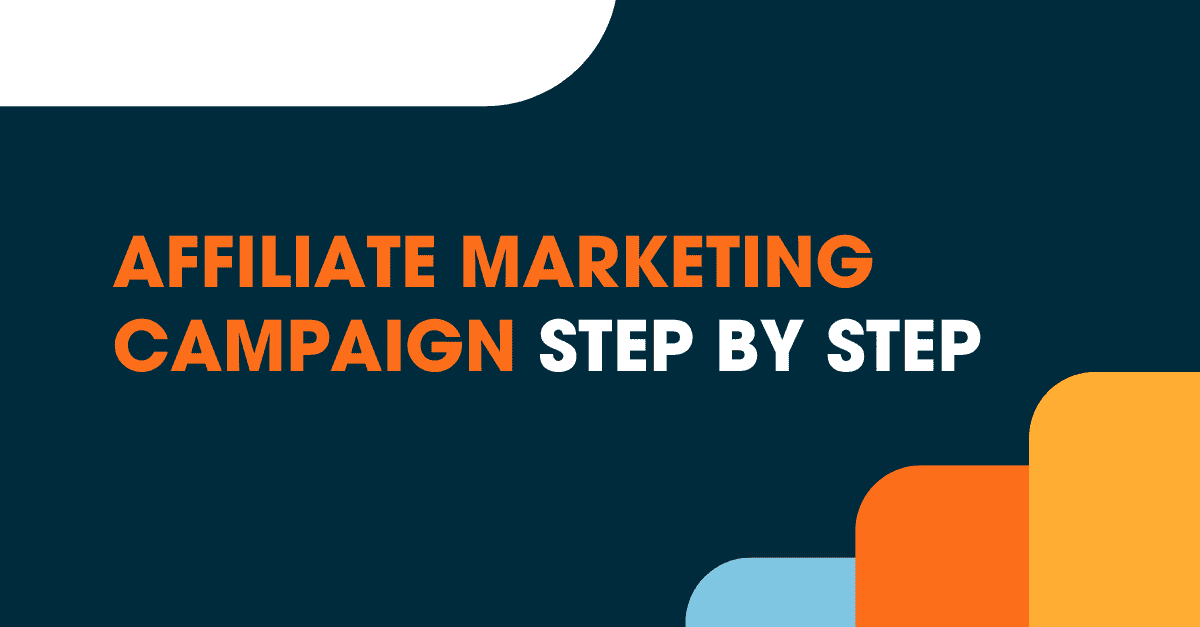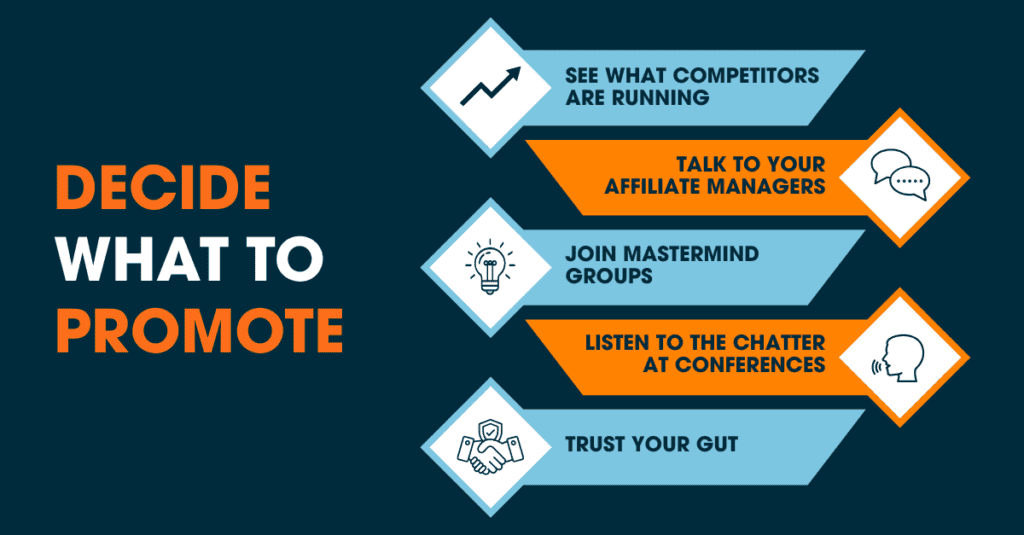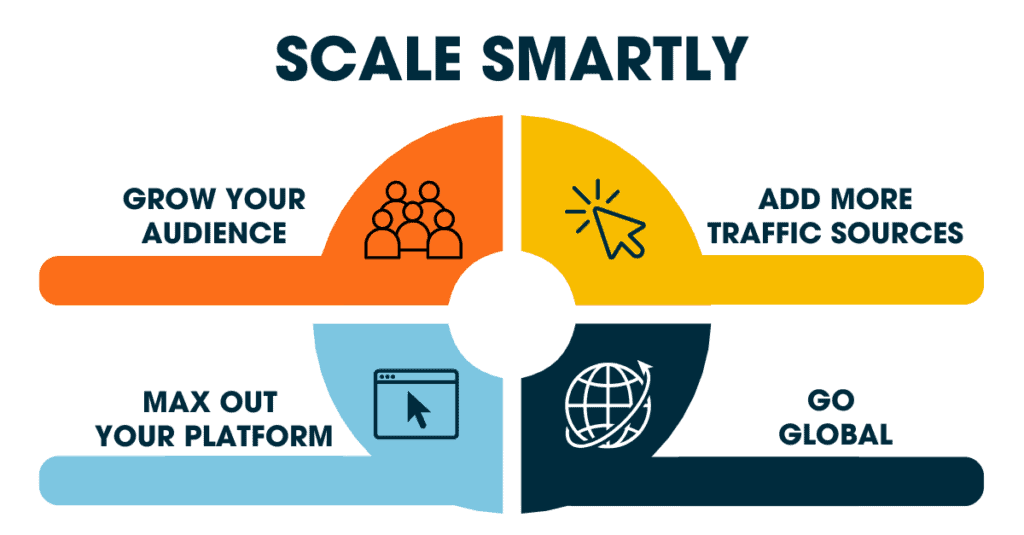
10-Step Blueprint for a Profitable Campaign
Confused about split-testing? Already making $100/day but want to scale? Overwhelmed by the sheer number of steps?
You’re not alone.
This guide simplifies the process. Whether you’re launching your first campaign or optimizing for higher ROI, these 10 steps remove the guesswork and get you results—faster.
1. Decide What to Promote
Every great campaign begins with two core decisions: which traffic source to use and which offer to promote.
The best strategy? Master one traffic source before adding another. Trying to juggle multiple at once leads to burnout, not profits.
Start by picking a high-ROI traffic source, like:
Next, match it with a winning offer. If mobile traffic is your focus, look at what’s performing well—say, antivirus offers.
Pro Tip: Avoid overanalyzing. No traffic source is “perfect.” Pick one, commit, and start testing. The real learning happens after launch.
- Google Ads
- Meta Ads
- TikTok Ads
- Mobile traffic networks
Yes, there are niche platforms out there too, but these four are where affiliates consistently see real results. They’re battle-tested and scalable.
Here’s where most people get stuck: they try to over-optimize the decision. They bounce between traffic sources, waiting for some kind of perfect answer. Truth is, there isn’t one “best” option. Every platform has strengths and trade-offs.
What matters most? Pick one, commit, and take action.
Don’t fall into the trap of researching forever—like someone who studies every workout plan but never actually hits the gym. That won’t get you results.
When you choose a major traffic source—like Google Ads or TikTok—you remove a key unknown: you know the traffic works.
So, if your campaign flops, you can improve it knowing the traffic source isn’t the problem. But if you bet on a new or untested source, you won’t know what’s broken—the traffic or your offer.
As for picking the right offer, it’s not guesswork. Use real signals:

- See what competitors are running
- Talk to your affiliate managers
- Join mastermind groups
- Listen to the chatter at conferences
- Trust your gut (once it’s informed)
2. Research the Offer
Smart affiliates don’t launch and hope—they prepare. Once you’ve picked your traffic source and offer, it’s time to dive into research that gives you a competitive edge before you even go live.
Start by spying on your competition. Use tools like Adplexity or WhatRunsWhere to see what creatives are being used across your vertical. Go beyond affiliate ads—look at major brands in your niche. Running a diet offer? Analyze Jenny Craig and WeightWatchers.
Talk to your affiliate manager—they often have insights into what’s working right now, which creatives are converting, and how top affiliates are positioning similar offers. Don’t overlook this resource.
Then, go through the funnel yourself. Understand the user journey. Who is the offer targeting? How does it monetize? If the offer exists on multiple networks, it’s worth split-testing them. Even identical offers can perform differently depending on tracking, redirect times, or scrub rates.
3. Plan It Out
Jumping into a campaign without a plan is like heading into battle blind. Before you launch, map out the entire strategy—from creative angles to budget allocation—so you can see the big picture and spot gaps early.
Use a mind map to lay out each piece of the puzzle. It helps you visualize how everything connects and ensures nothing slips through the cracks.
Break your campaign into smaller, manageable goals with realistic deadlines. These milestones will keep you focused and make it easier to track progress.
And here’s the key: stay flexible. Your initial plan is a starting point, not the final word. Once real data starts coming in, you’ll need to tweak and refine it. That’s how expert media buyers scale smarter, not harder.
4. Create Winning Creatives
If you want your ad campaigns to perform well, strong creatives aren’t optional—they’re essential. In fact, some of the biggest wins in affiliate marketing come down to how well your ads and landing pages connect with the audience.
Let’s be clear: copying your competitors’ ads might seem like a shortcut, but it’s a fast track to falling behind. Great performance doesn’t come from blending in. It comes from standing out.
So, how do you consistently create winning creatives? Here’s a simple, proven 3-step framework:
- Brainstorm angles that tap into your audience’s needs or pain points.
- Find high-impact visuals that stop the scroll and match your message.
- Design landing pages that mirror your ad tone and guide users toward the conversion.
Now here’s the honest part: coming up with high-converting creatives takes time and experience. It’s not always easy to explain what makes something “work,” but over time, you’ll start to feel when an idea has potential—even before launch.
The best way to sharpen that instinct? Practice. Test. Learn. Repeat. Every campaign, even the ones that flop, teaches you something.
5. Set Up the Backend
Before you launch any performance campaign, make sure your technical setup is solid—this is the foundation that keeps everything running smoothly and tracks every click, conversion, and dollar spent.
- Start with smart tracking:
Never launch without proper tracking in place. It’s how you measure performance, optimize results, and scale campaigns with confidence. - Choose the right infrastructure:
A solid VPS (virtual private server) is the minimum requirement to ensure your campaigns run smoothly. Don’t cut corners here—speed and uptime matter. - Register your domain properly:
Pick a clean, trustworthy domain through a registrar, and make sure you enable WHOIS protection. It keeps your personal info private. - Set up your landing pages on a separate server:
- For better performance and faster load times, host your landing pages separately from your tracking server. It may seem like an extra step, but it can improve user experience and boost conversion rates.
Now, let’s talk about the front-end setup—the visible side of your campaign that connects with your audience.
- Uploading ads can take time—especially with strict traffic sources like Meta or Google:
Expect some back-and-forth, but patience and precision here are worth it. Make sure everything aligns with platform policies to avoid delays or disapprovals. - Don’t forget account funding and paperwork:
Whether it’s signing invoices or topping up balances, these operational details keep your campaigns running without interruption. - Set up your tracker and launch the campaign inside your platform:
Configure everything properly—UTMs, events, conversion goals. A well-set tracker helps you spot what’s working (and what’s not) faster.
Testing every component before launch ensures that no dollars are wasted on broken links or delayed load times.
6. Launch and Collect Data
Start small. A $30–$50 test budget is all you need to validate that everything’s working. At this stage, you’re not optimizing for profit—you’re collecting clean, usable data.
Confirm that:
- Your tracking is accurate.
- Conversions are being recorded.
- The user flow from ad to offer is smooth.
Too many affiliates rush this part and end up spending hundreds—or thousands—on campaigns that never had a chance due to technical errors. Be patient here. The right data sets the stage for your first big win.
7. Split Test Like a Pro
Most campaigns don’t start out profitable—and that’s completely normal. At launch, it’s common to see negative ROI. But the winning campaigns you see others scale? They’re not lucky breaks. They’re built through smart, consistent optimization.
Let’s walk through a real-world example of how that looks:
- You launch the campaign. It’s at -100% ROI. Not great, but it’s a starting point.
- Test #1 – You try 3 different offers. One performs better than the rest. You stick with that. Now you’re at -50% ROI.
- Test #2 – Next, you test 10 ad creatives. You run the top 3. ROI improves to -10%.
- Test #3 – You experiment with 5 landing pages. One clearly outperforms the others. You roll with it. Now your ROI is +25%.
This is how winning campaigns are made—not by chance, but by methodical testing and smart decision-making.
Optimization process variables:
- Ads: Don’t just chase the highest CTR. A great click-through rate is meaningless if the ad doesn’t convert. Focus on ROI, not vanity metrics.
- Landing Pages: Play with layouts, images, headlines, and copy styles. Even small changes can lead to big gains.
- Bids: There’s no one-size-fits-all approach. Test different bidding strategies and adjust based on performance.
- Day & Week Parting: Identify the hours and days your campaign performs best. Scale what works. Cut what doesn’t.
- Offers: Test multiple offers. Once you start seeing volume, negotiate a pay bump or go direct with advertisers if it’s an option.
Create a repeatable testing process tailored to each traffic platform. The way you optimize on Google won’t be the same as on TikTok or native.
8. Analyze and Optimize
Now that you’ve got real data in hand, it’s time to put your critical thinking to work and level up your campaign.
Start by tracking daily profit and performance metrics. The more detailed your records, the easier it is to spot patterns and opportunities.
- Ask yourself: what’s the 80/20 here? Which actions or variables are driving the majority of your results—and where can you double down for maximum impact?
- Be honest about performance: Just because a campaign is profitable doesn’t mean it’s worth scaling. What’s the real potential? Is it sustainable, or is it just getting by?
- Think long-term: can this campaign be systemized? Look for repeatable parts of the process you can outsource or automate. The goal is to free up your time while building a stronger, more scalable system.
9. Scale Smartly
In affiliate marketing—especially when you’re working with paid traffic—scaling is the name of the game. It’s what separates casual marketers from those running high-volume, high-profit campaigns. Why? Because paid traffic gives you the power to go big—fast.
Let’s break it down: scaling means taking a campaign that’s working and expanding it to reach a much larger audience. If you’re currently hitting 1 million people, why stop there? Imagine reaching 10 million. That’s how real growth happens.
Here’s how expert affiliates do it:

- Grow Your Audience: Look beyond your current reach. Whether it’s a similar demographic or a broader interest group, the more eyes on your offer, the more conversions you can drive.
- Add More Traffic Sources: If you’re crushing it on one traffic platform, don’t stop there. Expand to similar channels with the same targeting style—keep what works, and test new ground.
- Go Global: If the offer allows for international traffic, test in other countries. Translate your creatives and landing pages, and tailor them for each market. Global reach = global revenue.
- Max Out the Platform You’re On: Already using a platform like native or display? Here’s how to squeeze more out of it:
- More placements – Test your ads across different websites and sections.
- More ad sizes – A simple switch in dimensions can drive surprising results.
- Higher bids – With stronger margins, you can afford to bid more and dominate placements. Just make sure your campaign performance supports it.
As you scale, continue optimizing. Volume means nothing if ROI disappears. Keep testing, tracking, and adjusting along the way.
10. Maintain and Protect Your Wins
Here’s what truly sets top affiliates apart from everyone else: consistency and focus—even after they start seeing results.
A common pitfall? Success can lead to distraction. We’ve seen it time and time again across thousands of campaigns. Just because you’re making money doesn’t mean your work is done. In fact, that’s usually when the real work begins.
Let’s break it down with a quick real-world example:
- Two affiliates, A and B, are both profitable on the same traffic source and niche.
- Affiliate A gets comfortable. He starts dabbling in other niches to “diversify,” but without a clear strategy or enough testing. His focus slips, and his ROI drops to zero.
- Affiliate B stays sharp. He keeps optimizing—testing new creatives, tweaking landing pages, and hunting down fresh offers. His campaign keeps growing, and so does his profit.
Affiliate marketing isn’t a “set it and forget it” game. If you’ve found a winning angle, others will notice—and they’ll try to replicate or outdo it. The ones who keep testing, iterating, and scaling are the ones who stay ahead.
Time for Action
You’re closer than you think to launching a winning campaign. The tools are in place—the only thing missing is action.
Stop second-guessing. There’s no such thing as a perfect moment in performance marketing. The sooner you start, the sooner you scale.
Let’s turn that momentum into revenue.
Ready to launch? The best time to start was yesterday. The second best time is now.
Our Yep Ads affiliate managers are here to help you launch, optimize, and scale.
Let’s grow your earnings—reach out today!
